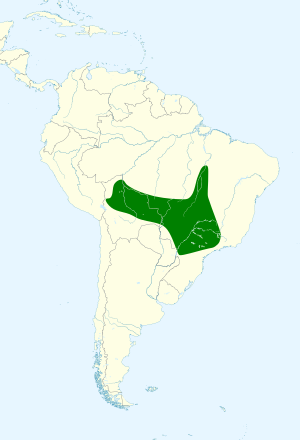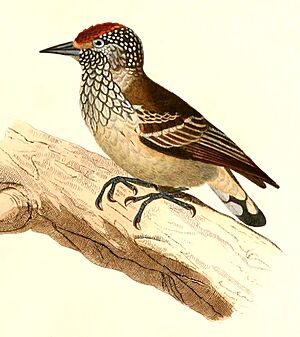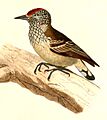White-wedged piculet facts for kids
Quick facts for kids White-wedged piculet |
|
|---|---|
 |
|
| Male at Bonito, Mato Grosso do Sul State, Brazil | |
| Conservation status | |
| Scientific classification | |
| Genus: |
Picumnus
|
| Species: |
albosquamatus
|
 |
|
The white-wedged piculet (Picumnus albosquamatus) is a small bird that belongs to the woodpecker family. It's found in parts of South America, including Argentina, Bolivia, Brazil, and Paraguay. These tiny birds are known for their unique looks and how they live in the wild.
Contents
What is a White-Wedged Piculet?
The white-wedged piculet is a type of bird in the woodpecker family, but it's much smaller than most woodpeckers you might know. It's part of a group called Picumninae, which are often called piculets.
How Many Types of White-Wedged Piculets Are There?
There are two main types, or subspecies, of the white-wedged piculet. They are called P. a. albosquamatus and P. a. guttifer. Sometimes, P. a. guttifer was thought to be a separate species. However, scientists found that these two types often mix and have babies together. This means they are closely related.
Can Piculets Mix with Other Birds?
Yes, white-wedged piculets can sometimes have babies with other types of piculets. This is called hybridizing. They have been known to mix with the white-barred piculet, the ocellated piculet, and the ochre-collared piculet.
What Does a White-Wedged Piculet Look Like?
These little birds are about 10 to 11 centimeters (about 4 inches) long. They weigh around 9 to 11 grams, which is about as much as a few paper clips!
Male and Female Piculets
Male white-wedged piculets have a black cap on their head. The feathers on their forehead have red tips, and the rest of the cap has small white spots. Their face and the back of their neck are mostly white with a brownish tint. They also have a white stripe behind their eyes.
Their upper body is warm brown or grayish-brown. Their flight feathers are dark brown with light edges. Their tail is dark brown, and the feathers closest to their body are mostly white on the inside. The outer tail feathers have a wide white patch near the end.
Their chin and throat feathers are light, pale white with black edges, which makes them look a bit scaly. Their belly is mostly whitish. The chest has a scalloped pattern from black feather edges. Their eyes are brown, and their beak is black with a lighter bottom part. Their legs are gray or green-gray.
Female piculets look almost the same as males, but they do not have the red on their forehead.
Young Piculets
Young piculets are not as brightly colored as adults. Their underparts look more striped than scalloped.
Differences in Subspecies
The P. a. guttifer subspecies is a bit larger than the other type. It's usually darker, with more contrast on its face. Its upper body has more of a scalloped pattern, and its underparts are warm buff with wider black edges on the feathers. Male P. a. guttifer also have more red on their head than the other type.
Where Do White-Wedged Piculets Live?
The P. a. albosquamatus subspecies lives in north-central and eastern Bolivia, southwestern Brazil (in the Mato Grosso state), northern Paraguay, and northwestern Argentina.
The P. a. guttifer subspecies is found in eastern and central Brazil, from the states of Pará and Maranhão south to Mato Grosso and São Paulo.
What Kind of Places Do They Like?
These birds like to live in dense areas of moderately dry cerrado (a type of savanna). They also live in gallery forest, which are forests that grow along rivers. They can be found from lowlands up to high places, sometimes as high as 2,100 meters (about 6,900 feet) above sea level.
How Do White-Wedged Piculets Behave?
Do They Move Around a Lot?
As far as we know, white-wedged piculets stay in the same area all year round. They don't migrate to different places.
What Do They Eat?
Scientists don't know much about how white-wedged piculets find their food or exactly what they eat. However, we do know that their diet includes insects.
How Do They Reproduce?
The breeding season for white-wedged piculets seems to be mostly in the second half of the year. They make their nests in holes. Some nests have been seen in tree branches, and at least one was found in a fence post. They usually lay at least two eggs. Both parents help feed the baby birds. We don't know how long it takes for the eggs to hatch or for the young birds to leave the nest.
What Sounds Do They Make?
The white-wedged piculet makes a "high-pitched trill." It sounds like it goes up a little bit at first, then slowly goes down in pitch, like "tititititititititititi."
Are White-Wedged Piculets Safe?
The IUCN (International Union for Conservation of Nature) has said that the white-wedged piculet is a species of "Least Concern." This means they are not currently in danger of disappearing. They live in a large area, but we don't know exactly how many of them there are. Their numbers are thought to be slowly going down.
No major threats have been found that would put them in immediate danger. They live in three national parks in Brazil and are considered "locally not uncommon" in other areas, like the northern Pantanal.
See also
 In Spanish: Carpinterito albiescamoso para niños
In Spanish: Carpinterito albiescamoso para niños
Images for kids




